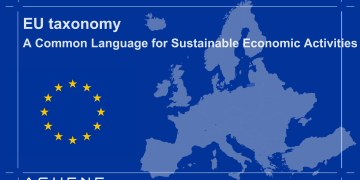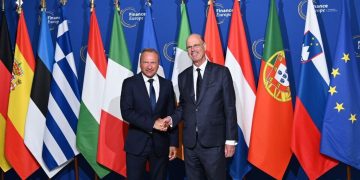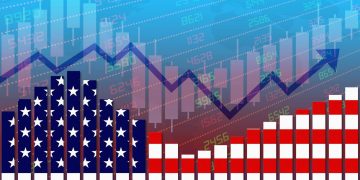Capital Flows, FX Dynamics, and Global Risk Repricing
Introduction: A New Phase of Transatlantic Monetary Decoupling
In 2024–2025, global markets entered a decisive new phase in monetary policy. For the first time since the immediate post-pandemic period, the Federal Reserve and the European Central Bank (ECB) are clearly diverging in their policy paths. While the ECB has already begun a persistent rate-cutting cycle—moving aggressively to ease financial conditions in the Eurozone—the Federal Reserve remains comparatively cautious, keeping rates higher for longer in response to sticky inflation, resilient labor markets, and concerns about overheating in sectors such as housing, services, and technology.
This divergence is reshaping capital flows across the Atlantic, driving volatility in currency markets, repricing sovereign debt, and altering global risk dynamics. The transatlantic interest-rate gap—once narrow—has widened again, pushing investors to reposition aggressively. The euro, U.S. dollar, corporate bonds, equities, and emerging-market assets are all being revalued through the lens of this shift.
As 2025 unfolds, the question is not merely whether the U.S. or Europe is “ahead” or “behind” on rate changes. Instead, it is about how the structural differences in inflation, growth, labor markets, and political risk between the two economic blocs create long-lasting monetary asymmetry.
This article examines the nature, causes, and consequences of the current Fed–ECB divergence—and the financial landscape it is creating.
I. What Is Driving the Divergence?
1. Different Inflation Structures
The U.S. economy continues to experience stickier service inflation, driven by:
- strong wage growth
- elevated consumer demand
- sustained spending in travel, hospitality, health care, and housing
In contrast, the Eurozone’s inflation is driven more by:
- energy price fluctuations
- supply-side factors
- weaker domestic demand
- a slower wage-price spiral
As a result:
- The Fed sees inflation as demand-driven → requiring tighter policy.
- The ECB sees inflation as supply-damped and weakening → allowing easier policy.
2. Growth Divergence
The U.S. economy remains notably stronger:
- GDP growth outperforms major developed markets.
- Consumer balance sheets remain healthier.
- Corporate earnings remain resilient, driven by tech, energy, and industrial sectors.
Meanwhile, the Eurozone faces:
- stagnant or near-zero growth in Germany
- weak manufacturing cycles
- structural labor market rigidities
- slower productivity growth
Thus the ECB cuts to support growth, while the Fed holds firm to cool demand.
3. Labor Market Asymmetry
The U.S. labor market remains tight:
- unemployment at historically low levels
- robust job creation
- strong wage growth
The Eurozone experiences:
- higher unemployment
- weaker wage pass-through
- large variation across member states
The Fed has more reason to fear overheating, while the ECB sees slack.
4. Political Risk Differences
The U.S. faces:
- heavy fiscal deficits
- elevated Treasury issuance
- potential inflationary impulses from industrial policy
Europe faces:
- energy security concerns
- recessionary risks
- fragmentation between northern and southern fiscal policy preferences
All these elements contribute to the growing divergence.
II. How Markets React: Capital Flows and Asset Allocation
When central banks diverge, capital reallocates rapidly—especially between two regions as deeply linked as the U.S. and Europe.
1. Investment Flows to the United States
Higher U.S. yields attract global investors:
- European pension funds repatriate capital toward U.S. Treasuries.
- Global asset managers rebalance portfolios toward dollar assets.
- Corporate treasuries seek higher short-term returns in U.S. money markets.
This strengthens the dollar and tightens global liquidity conditions.
2. Outflows from Euro-Denominated Assets
As ECB cuts reduce euro yields:
- European sovereign bonds offer less carry.
- Corporate bond spreads compress, reducing attractiveness.
- Equity markets suffer from weak earnings growth.
Investors move toward higher yield opportunities abroad.
3. Rise in Hedging Demand
Investors increasingly hedge currency exposure:
- European investors buying U.S. assets hedge the stronger dollar.
- U.S. investors reduce exposure to euro depreciation.
This creates additional cross-border FX demand.
4. Increased Foreign Demand for U.S. Treasuries
American debt appears more attractive:
- higher yields
- deep liquidity
- perceived safety amid geopolitical tensions
The divergence effectively subsidizes U.S. borrowing costs by pulling in foreign capital.
III. FX Market Dynamics: Dollar Strength, Euro Volatility
1. The Dollar’s Renewed Strength
A widening rate gap almost always strengthens the USD. As long as:
- U.S. yields remain higher
- labor markets stay tight
- inflation remains above target
the dollar maintains upward pressure.
2. The Euro Paradox
Despite ECB rate cuts, the euro has at times shown resilience—a paradox explained by:
- expectations that U.S. cuts are coming later
- European trade surpluses
- capital inflows into specific sectors (green tech, luxury)
- hedging activity that temporarily boosts EUR demand
But structurally, prolonged rate divergence caps euro upside.
3. Implications for Global FX Markets
- Emerging-market currencies weaken as USD strengthens.
- Safe-haven flows intensify.
- FX volatility increases as investors reposition around central bank speeches and data releases.
The Fed–ECB gap thus becomes a global volatility generator.

IV. Bond Market Repricing Across the Atlantic
1. U.S. Treasury Curve: Bear Steepening Risk
If the Fed keeps rates high:
- the short end remains anchored
- the long end prices inflation + fiscal risk
- the curve steepens
This environment supports carry trades but pressures leveraged strategies.
2. Eurozone Sovereign Bonds: Bull Steepening
ECB rate cuts cause:
- short yields to drop quickly
- long yields to fall more gradually
- easing financial conditions for governments
This supports heavily indebted nations like Italy, Spain, and France.
3. Corporate Credit Dynamics
U.S. credit markets remain supported by robust earnings.
European credit markets are more sensitive to growth downturn risks.
Divergence leads to:
- increased spread dispersion
- sector-specific differentiation
- more volatility around earnings results
V. Equities: Regional Divergence and Sector Winners/Losers
1. U.S. Equities Benefit from Higher Growth Expectations
Tech, energy, and industrials thrive in a high-growth–high-rate environment.
Strong dollar benefits:
- U.S. domestic-focused businesses
- corporations with dollar-denominated pricing power
2. European Equities Face Structural Headwinds
- weak earnings
- lower global demand
- currency uncertainty
- underperformance of cyclical sectors
Luxury, consumer staples, defense, and green industries show relative resilience.
3. Valuation Spread Widens
The divergence in:
- forward P/E ratios
- earnings growth
- profitability
widens the gap between U.S. and European markets, potentially attracting arbitrage flows.
VI. Global Risk Repricing: The Ripple Effects
1. Emerging Markets Face Pressure
Strong dollar + higher U.S. yields =
- weaker EM currencies
- higher borrowing costs
- capital outflows
Countries with dollar debt face heightened refinancing risks.
2. Commodity Markets React to Forex Moves
- Strong USD → downward pressure on dollar-priced commodities
- Weaker euro → higher import costs for Europe
Energy markets fluctuate with euro-dollar dynamics.
3. Financial Stability Questions
Differing monetary cycles can expose vulnerabilities in:
- money-market funds
- leveraged investors
- cross-border funding markets
Global regulators watch this closely.
VII. What Comes Next? Scenarios for 2025 and Beyond
Scenario 1: The Fed Cuts Late, ECB Cuts More → Wide Divergence Continues
If U.S. inflation stays sticky:
- dollar remains strong
- global capital flows into U.S. assets
- Europe faces growth stagnation
Scenario 2: Both Central Banks Cut Together → Convergence Resumes
If U.S. data softens sharply:
- Fed cuts aggressively
- euro appreciates
- European assets regain competitiveness
Scenario 3: Geopolitical Shock Forces ECB or Fed to Pivot Unexpectedly
Energy shocks → ECB slows cuts
Fiscal crisis → Fed reverses course
Global risk-off → dollar strengthens universally
Conclusion: A Structural—Not Temporary—Divergence
The current Fed–ECB divergence is more than a cyclical split—it reflects deeper structural differences:
- U.S. labor-market strength vs. European slack
- U.S. growth momentum vs. European stagnation
- differing inflation compositions
- political and fiscal asymmetry
These forces ensure that monetary divergence will continue shaping markets throughout 2025 and beyond.
The resulting world is one where:
- the dollar remains dominant
- capital flows favor the U.S.
- Europe’s monetary easing reshapes yields and growth
- global risk assets move in sync with central-bank narratives
The transatlantic relationship is entering a new monetary era—defined not by crisis, but by asymmetry.




































